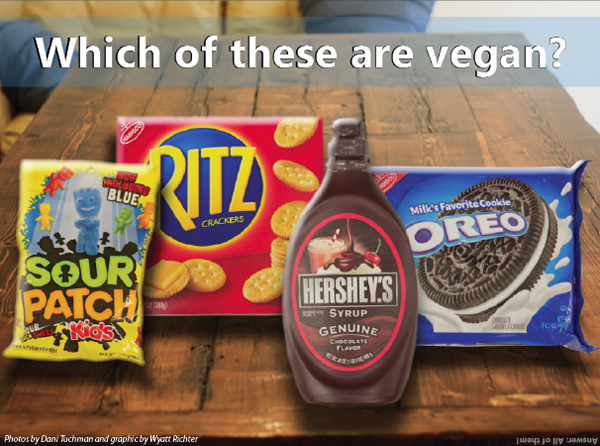I was exceedingly uninformed and unprepared as to what being anything but a meat-eater entailed prior to starting my two week-long vegan experiment. Veganism, otherwise known as abstaining from the consumption or usage of any animal products, initially made me deem 14 days without scrambled eggs, string cheese and my mom’s homemade brownies to be unthinkable. This was until, however, I saw the many benefits of temporarily changing my eating habits.
The comedic movie Keeping up with the Steins, released in 2006, portrays the basic stereotype of a vegan. Although the movie is otherwise irrelevant to veganism, one scene reveals a woman eating solely green beans and a dozen vitamins for dinner while her reason is “I’m a vegan.” Immediately after seeing that, my eight-year-old self thought, “Who would ever want to do that? She’s basically starving herself!”
In starting my dietary experiment, it was difficult to see past this movie’s vegan stereotype and to approach the experience with an open mind free of nonsensical presumptions. However, I found this choice to be entertaining when on my first day I accidentally bit into a strawberry doughnut and confused my Television class when I squealed and ran to spit it out.
That night, my dad amusingly ran to Whole Foods and jumped at the opportunity to stir-fry five different vegetables topped with tofu. Yes, tofu—one of the many soy-based meat substitutes that vegans have to love. Why? Well, haven’t you heard the saying, “It’s all fun and games until you struggle to get your protein?”
On the second day, I seized the opportunity to research more complex vegan recipes on Pinterest, such as the practical kale salad with cashew-parsley dressing. Sadly, none of the several dozen recipes that I bookmarked made their ways onto my stovetop. Instead, whenever I wanted something quick and easy, peanut butter sandwiches took the gold every time.
I originally couldn’t understand why certain people choose to follow a vegan diet. According to vegansociety.com, however, switching to a plant-based diet is an effective way to reduce one’s eco-footprint.
First, the livestock that supplies your beloved bacon and eggs is also reponsible for 18 percent of greenhouse gas emissions.
Plus, the not-so-shocking fact is that plant-based diets only require around one third of the land and water of a meat-based diet to provide for a typical Western meal. That means more untouched land and less factory-ridden middle-of-nowheres.
So in trying to fulfill three, well-balanced Westerns meals for every day of the week, I consumed a lot of soy—a great source of vegan protein–such as edamame, soy-based meat substitutes, and soy yogurt. Almond milk replaced the normal Oberweis milk in my cereal and second helpings of vegetables substituted for second helpings of ice cream. Instead of wearing leather boots to school, I sported Converse sneakers every day.
After learning that, according to vegansociety.com, less than 1 percent of Americans choose to lead a vegan lifestyle, I progressively became more surprised that this number is so low. The diet worked for me; I experienced numerous physical and mental benefits. I slept more easily, felt more energized, and was encouraged to eat more fresh fruits and vegetables than I was prior to the experiment.
Currently, I am continuing a vegetarian lifestyle—abstaining from meat but once again consuming eggs and dairy. I am doing it to have a healthier diet and not contribute to animal cruelty. I cannot rid the world of slaughter houses, but I can do my part and I can, according to People for the Ethical Treatment of Animals (PETA), personally save over 100 animals a year.
Vegan experiment reveals notable mental, physical benefits
Dani Tuchman, asst. opinions editor
March 14, 2014
Categories:

0







